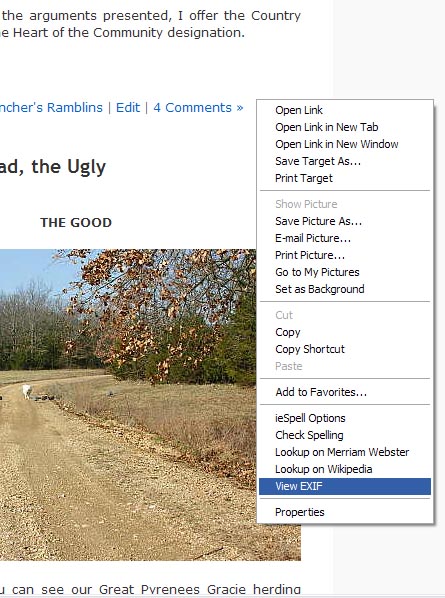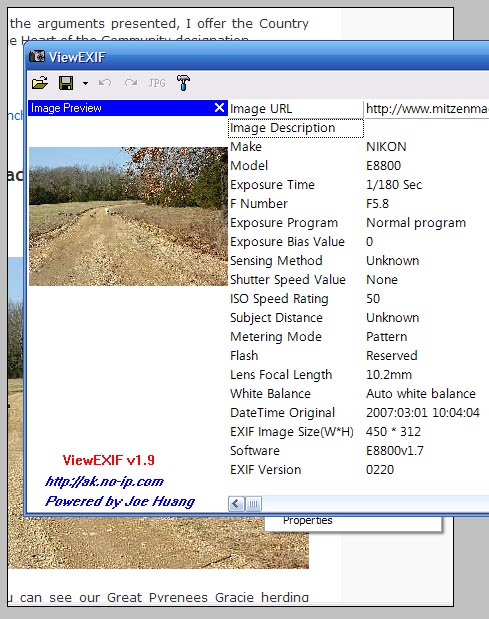In a recent posting, Pablo presented another fine article about that bit of land at the edge of the Ozarks that he calls Roundrock. Within the post Pablo expressed uncertainty over the exact date that a photograph was taken. With one mouse click, I was able to present Pablo with this needed information.
Of course, Tjilpi  (that rascal) noted that I might just have the power to reach into Pablo’s desktop to obtain that information. If I did have that power, I promise that I would only use it for the good of mankind, but I must confess to much lesser degree of technical prowess than that. Here’s the secret. The Exif header.
For those of you who want to explore this thing called the Exif header in detail, this article from Wikipedia can point you in the right directions. But here’s my nutshell explanation.
One of the powerful properties of a data file is the fact that many differing types of data can be stored together in the same place. This creates some great opportunities when applied to the realm of digital image files. When an exposure is made with a modern digital camera, the resulting image file that is created will contain 2 types of data – header data and image data.
The image data, as the term suggests, contains the specifications that define the actual image that we view, such as the picture that you see on a computer monitor, or the printed output from your color printer.
The header data, on the other hand, is an eclectic but useful combination of data relating to the image that it accompanies. You might be surprised to learn how much information accompanies each digital image file, much of which can be put to good use by the photographer and his/her software.Â
First, the basic camera settings at the time of exposure are included in the data. This can be quite useful at times, for instance when Pablo needed to find the date a particular photograph was taken. Along with the date and time, of course, the file includes a detailed record of parameters such as f-stop, shutter speed, ISO settings, metering mode, focus distance, flash mode, etc.  It is very useful to be able to review the camera settings when critiquing your photos. You may discover which camera settings work for you, and which don’t under various photographic conditions. Those of you with multiple digital cameras will appreciate that the Exif file records the camera make and model number, so you can identify which camera was used to produce any given photo.
Second, a thumbnail version of the full size image is usually stored in the Exif header. This speeds up the operation of most modern image editing and viewing software, and provides a way for your camera to quickly display the image for review in the camera’s LCD monitor.
Third, the Exif header contains information that may be used to convey hardware dependent information along with the photograph, such as color matching hardware profiles. While out of the scope of this post, the idea behind color matching is to provide a means whereby the image that is displayed on the screen, or output to the printer, will look the same.  For example, if you have a desktop computer with a CRT display and a laptop with a TFT or LCD display, you will soon discover that the same image file may look different when viewed side-by-side. When set up and calibrated properly (a science onto itself), your hardware can be “trained” to display the images with a close match. The information contained in the color matching profile, which can be included in the Exif header, is used as a part of this process.
Accessing Exif Information
Most image editing software has a means of showing the Exif header information. Photoshop, for instance displays this information beneath the folder tree pane when a file is highlighted in the File Browser, or through a File-Properties menu selection. Check you help file if you haven’t already figured out how to view this information in your own image editing software.
Windows XP and Mac OS10 x will also reveal Exif data from your image file. For the Mac, Exif information may be viewed in the Finder by doing Get Info on a file and expanding the More Info section. For Windows XP, right-click on the image file and select Properties, then click on the Summary tab at the top.
For a stand alone program to examine Exif files, I use Exif Image Viewer, which is freeware available here.
What I find most useful, however is to be able to easily examine the Exif header information for photographs that I am viewing in my web browser, such as the photograph that I saw at Roundrock Journal.  You can learn a lot from examining the Exif data of photos you find appealing. For this application, I use a little gem of freeware called ViewEXIF, which is available here. This installs itself as an extension to Internet Explorer or the Firefox browsers, and is simple to use. Here’s how to do it.
1. Download and install the software.
2. From now on, when you right-click on any photograph displayed in your browser, you will see a screen like the following:
_________________________________________________
_____________________________________________
You can see in the screen capture above that the Context Menu that pops up now has a new option – View EXIF. Select this option, and the following window will immediately pop open:
So there you have it – a quick and dirty primer on the Exif header file. Now, learn to use these tools, and go forth wisely with your new found knowledge!
PS – Answer to the title of this post – Exchangeable Image File Format





Thanks for that Hal. I’ve now got View EXIF on right click in IE7.
Now that I can get into Pablo’s camera I’ll have to start working on a project to get into his mind!
[Or maybe I’ve already succeeded at that ;-} ]
Hal thanks so much for this. It seems the older I get the “dumner I become”.
I don’t mess around with poking into Pablo’s photos, I slip into RR every once in a while and rearrange his round rock piles, change the water level in his lake, and loosen the knots on his torpor tent.
Don’t tell.